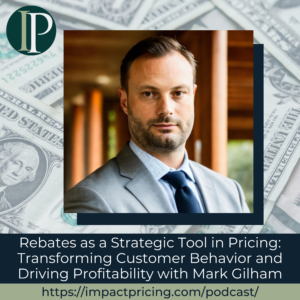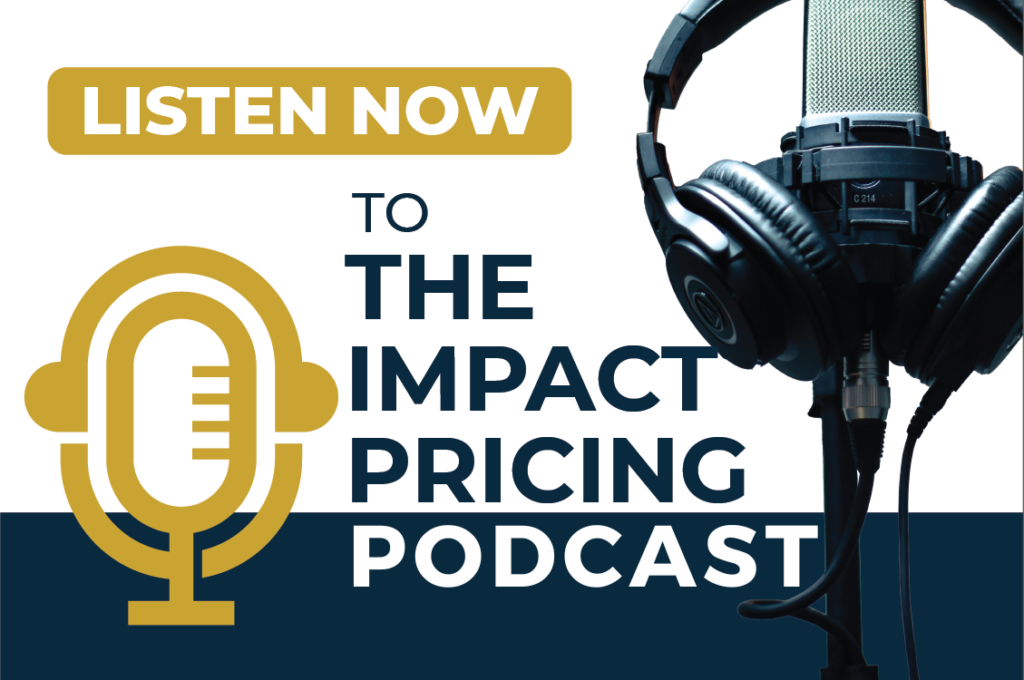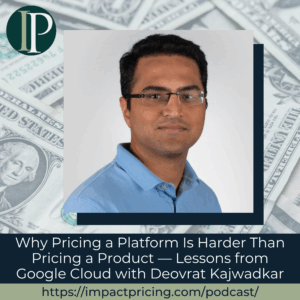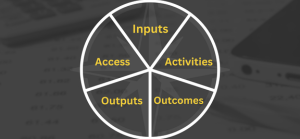Mark Gilham is an experienced senior executive with a proven track record in finance, strategy, and consulting. He brings deep expertise in driving commercial success, improving operational efficiencies, and influencing industry best practices.
In this episode, Mark shares the transformative power of rebates as tools for driving both customer behavior and operational efficiency, rather than just cost-cutting mechanisms. He highlights the importance of designing rebates that align with business goals, such as incentivizing desirable customer actions, improving operational processes, and fostering long-term loyalty.
Podcast: Play in new window | Download
Why you have to check out today’s podcast:
- Learn how rebates can go beyond simple cost-cutting to solve operational challenges, enhance customer loyalty, and drive profitability for your business.
- Gain insights into how rebates can incentivize customer behaviors that benefit both parties, creating a more collaborative and sustainable business relationship.
- Discover innovative ways to use rebates to optimize your operations, create efficiencies, and stronger partnerships with customers.
“Get out from behind your desk; get away from the spreadsheet and understand your business. Understand what makes your business tick.”
– Mark Gilham
Topics Covered:
01:11 – How he transitioned from accountancy to pricing
02:24 – Explaining why accountants’ focus on cost-plus pricing
03:52 – Highlighting how understanding pricing enables finance professionals to interpret data more effectively and influence business outcomes
05:35 – Strategic role of rebates in B2B, their challenges, and how they differ from traditional incentives and discounts
08:18 – Importance of structuring rebates and balancing discounts and rebates in B2B to maintain margins
11:11 – Dynamics of incentivizing end consumers versus channel partners
14:59 – Optimizing rebate structures
20:40 – Sharing how rebates can incentivize operational efficiency
25:55 – Advocating for pricing teams to lead rebate strategies to create lasting customer relationships and reduce reliance on discounting
28:11 – Highlighting the potential of rebates to address operational inefficiencies
Key Takeaways:
“Immature pricing practices tend to be that cost-plus. And when I say immature, it’s not that it’s bad, it’s just they don’t know what good looks like or what’s better.” – Mark Gilham
“A good rebate is a rebate that a manufacturer or supplier wants to pay out.” – Mark Gilham
“I believe pricing have the tools and the skillset to, and it should be on the sell side, to equip salespeople to go out, not to win an order, but to kind of win a relationship. And make that relationship sticky so that discounting actually is not, it’s always going to be important, but hopefully you can take a little bit of that pressure off the table.” – Mark Gilham
“If you want a better deal from your supplier, think about all the things you could do to make their life easier and ask them, ‘What’s that worth to you?’ And that’s a far better way of getting a bit of extra money out of the contract than just saying, ‘I want my product for less.’” – Mark Gilham
People/Resources Mentioned:
- Enable: https://www.enable.com
Connect with Mark Gilham:
- LinkedIn: https://www.linkedin.com/in/markgilham/
- Email: [email protected]
Connect with Mark Stiving:
- LinkedIn: https://www.linkedin.com/in/stiving/
- Email: [email protected]
Full Interview Transcript
(Note: This transcript was created with an AI transcription service. Please forgive any transcription or grammatical errors. We probably sounded better in real life.)
Mark Gilham
Get out from behind your desk; get away from the spreadsheet and understand your business. Understand what makes your business tick.
[Intro / Ad]
Mark Stiving
Welcome to Impact Pricing, the podcast where we discuss pricing, value, and the symbiotic relationship between them. I’m Mark Stiving and I run boot camps to help companies get paid more. Our guest today is Mark Gilham. Here are three things you want to know about Mark before we start. He is the VP and head of advisory at Enable. He’s really a CFO by background, which we’ll learn more about. He spoke about rebates at PPS, which is why I wanted to have him on because I’ve never talked about rebates before. And by the way, he had drinks with Superman. Welcome, Mark.
Mark Gilham
Hi Mark. Nice to be here.
Mark Stiving
It’s going to be great. Let me ask you the question that may not fit you perfectly. How did you get into pricing?
Mark Gilham
I think like most people, this was not through a career fair where I decided that was going to be my route. I always wanted to get into accountancy, as my grandfather did. And then through accountancy pricing was one of these operations that was handed to me. And probably all prices are thinking, ‘Oh no, don’t give it to finance.’ But that’s what happened. And I found it really interesting. And this was more on the B2C side at the time, but I really did find it interesting and I thought, this is actually what makes the business tick. This is the difference between profit and loss in my opinion. And this is where accountants should really expand their skill set to better understand this field kind of commercial strategy.
Mark Stiving
Wow. If only all CFOs and accountants thought like you did, that would be awesome. I tend to be really cautious when CFOs want to get involved in pricing because it’s almost always, at least in my view, it’s almost always cost-plus. And we’re not thinking about the value to the customer as much because the CFO just doesn’t understand the customer the way other people inside the company do.
Mark Gilham
Yeah, I think immature pricing practices tend to be that cost-plus, and when I say immature, it’s not that it’s bad, it’s just they don’t know what good looks like or what’s better. When you become an accountant, they don’t teach you how to price. They tend to be a lot higher level. And so I think it’s just naturally the first thing that somebody leans towards. And accountants we’re very concerned about margin. Well, if we’re concerned about margin, there’s two things that go into that sales price and cost. And we can’t, we generally don’t feel we can influence sales price. So we tend to look a lot at the cost. And I think that’s where it goes. But I am seeing more and more accountants who want to be more commercial. They don’t want to report the past, they want to influence the future. And I would encourage them, I’ve been speaking to Kevin, Professional Pricing Society saying the next breed of prices could come from accountants. If we can educate them, if we can and get these people to really see the benefits of moving beyond cost-plus pricing.
Mark Stiving
Yeah, interesting comments. I would say accountants don’t have much authority inside a company, but if you go to finance, I think finance has a ton of authority inside a company and you could move pricing in that direction much more easily than you could to accounting.
Mark Gilham
Yeah, absolutely. I think one of the things, I mean, to me there’s a couple of hurdles when it comes to having authority. One is access to the data to start with and being able to work with these things and have the tools to process this data. Thankfully, finance tends to be given access to what they ask for in terms of that.
Mark Stiving
Tend to be, they get everything they want. What are you talking about?
Mark Gilham
So, as accountants or as finance, we have all of that information. And then the other thing is, we’re generally asked to interpret it. Why did the business make less money last month? That for me is where pricing really helps. If you understand pricing, you can give a far better answer to that question. And if you can give a far better answer, it means you can influence it for the next month. And because there’s nothing worse than an accountant who just says, well, set revenue is down 5%, and they say, why? And then, ‘Oh, because we sold things for less.’ Well that doesn’t really help the business. Whereas, actually if you understand pricing, you can maybe explain in a bit more detail as to how to curb that trend.
Mark Stiving
Yeah. Excellent. I think we could talk about this for the whole podcast, but I really want to talk to you about rebates because honestly, I’ve rarely used rebates and I’ve never had anybody on the podcast to talk about rebates before. So we’re going to talk about rebates. So, first I’ve certainly filled out rebate forms in the B2C world, and it feels kind of weird to me to do that. It feels like I’m never going to get my rebate and I think occasionally I actually get one back. But go ahead and tell me, when you just think rebates, what are you thinking? How do you describe the whole world of rebates?
Mark Gilham
For me, there’s definitely a couple of worlds of rebates. There is the B2C and the incentive programs. There’s the, what I deem as almost the cashback offers, there’s the loyalty schemes, but where I’m more focused is in the B2B world, which is, there’s a lot of money trading hands in B2B and a lot of rebates behind these scenes. And it’s probably where rebates get more of a bad reputation, to be honest. There’s a lot of people who would say there are costs to do business between two parties and necessary evil. I’ve heard all of these things and as a software company where I work for Enable, that’s what our software originally started having to do, was just to make these burdens and these costs less painful. But as I worked more and more with rebates, what I realized was there is actually a better way to do it, a better way that no software is going to fix for you. It is a strategic piece. And where we started to get into this was I was speaking to lots of pricing professionals
And they were not looking at rebates. And so for me, I started to explore, well, when we’re thinking of rebates, are we thinking of incentives? And so as an example, businesses who might say, ‘Well, if you spend a million dollars with us this year, we’ll give you 5% back.’ Well, we know what the volume trade off is in the world of pricing for a 5% discount, but I can almost guarantee you that when rebates get awkward, they don’t do the same level of maths. And so they offer these rebates hoping for growth and in some cases they might get it, but often they don’t. So this is really what, they’re supposed to drive loyalty and stickiness in relationships. But unfortunately when they’re left to two people just to negotiate, they almost become forms of secondary discounts. In some cases, especially if they’ve got a sales initiative or sales targeting, if you can do a rebate and it doesn’t affect your sales numbers, even better. But from an accounting perspective…
Mark Stiving
Now, I was going to say, so one of the things I’ve heard about rebates, and tell me if you’ve seen this or if it’s true or not, but that is, if we do the example you just gave, ‘Hey, if you sell a million dollars, we’ll give you a 5% rebate,’ that they assume they’re getting the 5% rebate no matter what. Even if they only sell 750 K and that the selling company usually gives them that rebate. So, it’s really like a discount that’s not actually an incentive to go do something. Is that true?
Mark Gilham
It can be. I do see cases where businesses put some structure behind it to make it look or appear almost more credible, but then end up paying out the rebate. I would say like anything there should, maybe there would be a degree of tolerance, but ideally a target is a target. I get it. If your customer just misses it and there’s a valid reason. For example, you might have had a stock out in the middle of the year and you couldn’t supply. But generally this is all about conditioning your customers. We talk about if you give them discounts when they ask for them, well, you condition them that way and then they never buy from you unless they get a discount. The same applies with rebates and incentives. How you condition your customers in that arena is really important.
Mark Stiving
Okay. Another thing I heard that’s really weird about rebates and I’d love to know how you address this, is that if I give a discount, the procurement guy got credit for getting a discount. If I give a rebate, we don’t really know who gets the credit. And individuals getting credit seems to be important in making these B2B transactions.
Mark Gilham
There is definitely in B2B, everybody justifying the value they’ve added in their role. I often see it the other way around. Whereas if they give, if the procurement person secures a discount, it gets lost in trading. So what they do is they ask for a rebate instead. But where that becomes dangerous is rebates get added to rebates which get added to more rebates. And before you know it, your entire margin of a product just sat in the rebate. So it kind of goes both ways there for me it’s like everything, it’s the right kind of outcome for the right scenario. The one thing you should always be very mindful of with a discount versus a rebate when you’re procuring is, how do you price the product onwards? Because if your sales team is cost-plus and you take a discount, they’re going to sell it to the customer for less. But if you take a rebate, you’ve shielded and protected the procurement gain you’ve just received. So, rebates are healthy but only to a certain point. You don’t want too much rebate because then the sales team see costs that they don’t believe they can trade and then they start guessing, which you don’t want to be there either.
Mark Stiving
So another place where I always wanted to use rebates back when I actually did pricing for a living, one of the places I wanted to use rebates was on the other end of my channel, right? So instead of giving my channel the rebate, I wanted to give the end customer the rebate. And to me that makes a ton of sense because I’m offering a discount directly to the customer because I know the channel’s going to do weird things. Do you see that happening very often and what are the pros and cons of that?
Mark Gilham
Yes. I see everything from only the end consumer being incentivized to everybody in the channel being incentivized. So some manufacturers, yeah, they pay the distributor, the contractor, the subcontractor, and the ultimate kind of recipient of the goods or services. The benefit is that you are recognizing who is the decision maker and who is the bill payer because they can be two different entities and it’s the decision maker ultimately who you’re trying to drive their behavior. But likewise, you want to keep the bill payer happy. The downside when you start missing steps is you are then dependent upon somebody else for your data. And generally, that data is not going to come for free.
So, I know a lot of retailers as an example receive sales out allowances, but they have to submit their POS data in order to, which is great for a manufacturer or somebody who’s paying it out because not only do you keep the end consumer incentivized, but you also get to see what’s actually going on in the demographics of the market, as well. Works very well in some industries, but in others there’s a lot of reluctance for that. I came from a distribution background and the idea of sharing POS data with our manufacturers would be very scary because we always felt we were in some kind of competition with our manufacturers. We always felt that if they could, they would cut us out. And the closer they are to the consumer, the lower our margin was. So we always wanted to keep them away from what we would deem as our customers, which is understandable, but it’s probably not ideal.
Mark Stiving
Yeah, it’s interesting because typically things work better when everybody’s transparent, but it also works better when everybody’s honest and fair. Yeah, so I used to be in the semiconductor industry and we sold through distribution and we got POS data. It was just part of the process. So, it wasn’t painful. And by the way, there was a standard, once a customer reaches some number, a million dollars we’re probably taking them directly, so right. It’s just the way it’s going to be. But everybody understood that was just what was happening and we used distribution because we didn’t want to handle customers that were under a million dollars or whatever that number happened to be. So, in that respect, it makes a lot of sense.
Mark Gilham
It’s really interesting because when I started to work in the construction materials or building materials industry, there’s brands I’d heard of as a consumer and there’s brands I hadn’t. And I would say almost as a rule, the brands I’d heard of we made as a distributor, half, if not even less as a margin compared to the brands I’d never heard of. Because what happens is, as soon as the manufacturer resonates with the consumer, the distributor has no choice but to stock and sell their product. Which means the manufacturer can actually say, well, if you don’t like my terms, then stop my product. Because the customer will walk in and say, I want a so and so, and if you don’t have it, they’ll go elsewhere. So the manufacturers who do very well are the ones who managed to get their product and their brand to resonate with the end consumer.
Mark Stiving
Yeah, I would say that’s partly true. Here’s the other side of that same story, and that is a customer walks into a distributor and says, ‘Hey, I need a new fan. And he doesn’t say who the manufacturer is, they just say, I need a new fan. Now, the distributor gets to recommend one. Who do you recommend? You recommend the ones with the bigger margin so the big brand name doesn’t get the sale.
Mark Gilham
Yeah, although I would say that, they, again, it really depends on your sales team. But what I would say is good distributors will give the customer the right fan for their price points and inevitably they walk away with the branded one unless they say, look, I don’t want to spend much money. So they end up with the kind of the non-brand. But yes, there’s always a flip side, but when it comes to these rebates, it’s really interesting the point you made earlier about the 5% of a million. I always joke about those two numbers because they’re actually quite common. And the reason I always joke about the five is because that’s how many fingers we have on a hand. So I’m guessing that’s why we always resonate at five. But there’s some things that businesses do in pricing with rebates. One tiny change changes the rebate altogether.
So as an example, rather than 5%, a million, 5%, a hundred thousand units, all of a sudden it’s inflation proof. so there’s lots of these little nuances that apply in the world of rebates. Should you, when it comes to rebates, should you have annual targets, quarterly targets, monthly targets? Should you have consistent targets? should you look for seasonality in your targets? Should you pay out quarterly? Or should you actually have quarterly targets but then pay annually. And if the customer leaves you at any point, they’re walking away from that money, should you pay by credit note, which means they’ve got to keep spending with you to use the rebate they’ve earned. And this is where people miss so much opportunity in the world of rebates, it’s not just the five in the million, it’s all the other things you can do to make it more effective to make it more attractive to your customer.
I love rebates, that, almost, you can gain them to a degree, not to your be well it is to your benefit, but it’s to both parties benefits. So the customer can say, ‘Well, actually if I bought a little bit more of this and I did this and I did this, oh actually look, I can now get 6.2%.’ And then going to the business and aligning with your pricing team, your sales team and saying, ‘Look, I’ve looked at our buying contract, we need to do this and we’ve got 6.2.’ And a good rebate should, in my opinion, facilitate these things. And a final point, a good rebate is a rebate that a manufacturer or supplier wants to pay out. Because what it means is, if it is a win share or profit share, it means the more you are paying out, the more profit you actually made in the process anyway. Bad rebates, like I say earlier, are a cost to do business. Probably you had no choice. It was a negotiation you had to give your customer that rebate. I’m trying to move us beyond that perception of rebate into something that’s far more collaborative.
Mark Stiving
That makes a ton of sense. Enable is a software company, but I got to say what you and I just talked about is truly what I need is someone to teach me how to do rebates, not someone to manage my rebates.
Mark Gilham
Yes. I was a former customer of Enable, so I used them when I was working in building materials because we started like everybody else on the spreadsheets and we were doing okay, but it was a headache and then Enable brought out a piece of software and it was great. So, I actually spent a bit of time working with them as a customer and then transitioned over as a, they had a terminal evangelist, somebody who would actually talk about the benefits of doing things with rebates in a better way. And the role has evolved because what we realized was that bad practices and good software still have bad outcomes.
Mark Stiving
Yep.
Mark Gilham
So we have a huge team of software people but what we don’t have, and especially of course industries are many people who can tell you what good looks like and how to do it as well. And that’s where my role has evolved into that space. And so now I spent a lot of time at Professional Pricing Society, really trying to educate people that there is a better way. Rebates can actually be used as kind of a commercial force for good, but at the same time, just like discounting, it can become your worst enemy if you don’t do it correctly and you don’t get control of it early on.
Mark Stiving
Yeah. So I have to say, I think the most powerful thing I’ve heard you say, I mean lots of great things by the way, but the most powerful thing I heard you say was that a rebate is something you want to pay out. Now, by the way, I might disagree with that a little bit, but here’s what I would absolutely agree with: a rebate is the incentive to say, ‘Here’s how I want my customers to behave.’ Right? And I think that’s an absolutely true statement. I think in B2C, if we go back to B2C for a second, I know that’s not what we’re talking about. I am sure that everybody who puts out a rebate coupon wants you to think, ‘Oh, I get $10 back, so I’m going to take $10 off the price and then never send in the coupon.’ I’m sure that’s what they want, right?
Mark Gilham
Yeah.
Mark Stiving
So, I don’t want to pay out the rebate, but I want you to behave like I’m going to pay out the rebate. And so I’m sure that’s exactly the same thing in B2B. We just happen to be more honest that we’re going to pay it out and it’s not as onerous and we want you to do these behaviors.
Mark Gilham
Yeah, I mean, a real example, I was working with a distribution company and they were a wholesaler to other distributors. And what would happen is, or their customers typically would replenish once a month and they would do it the week before the month end, they put their orders in. So this distribution company had a whole customer base whose kind of demand was all in this one week. And what it meant was they had to have resources to cover that week and that cost them a lot of money. And I was talking to them and I said, ‘Well, why don’t you incentivize your customers to buy at other points, place their orders at other times?’ And they went, that would be too complicated from a pricing perspective to have different prices depending on when you order. I said, well, you wouldn’t use pricing, you’re not going to start playing with price books here.
What you would do is you would say to them, ‘Maybe you’ve got a scheme first half of the month, second half of the month, and if your orders are maybe no worse than 60, 40, either way will incentivize you for that.’ And we ran the maths and everything, and the numbers made sense, which is always important. I’d always encourage people to look at that. But what it did was it allowed them to actually either reduce cost or increase capacity, which are both very powerful things. And that for me is an example of that wasn’t trying to create growth in that customer that was trying to create growth in their operation. And you can imagine a price wouldn’t be tasked with that. That’s more a supply chain thing, but it shows you the power of bringing the different areas together to say, ‘Hey, if we change our customer behavior, customers are loving this because they’re actually they’re now getting a rebate they never even asked for. They’re now getting their products cheaper purely by spreading out their orders. And we’ve now got more capacity.
Mark Stiving
I love the story, but I want to push back on something and feel free to tell me how I’m wrong. Why couldn’t this distributor have said, I offer a 2% discount for any orders that come in the first two weeks of the month?
Mark Gilham
The reason they didn’t want to do that was because what it would mean is that the price books of their customers they’d have to run different price books at different points in the month. So what would happen is, and that the other danger was that the customers would move everything to the first two weeks. They needed a split, if that makes sense. They wanted 50/50 ideally. So, if you give them the 2% discount flooding in the first two weeks, their customers would just all move to the…they’d still have the same problem. Does that make sense?
Mark Stiving
It does. By the way, I’m just playing in my head here so I could offer half my customers a 2% discount for moving to the first two weeks. I mean, there’s lots of different ways to solve the problem, but I find that fascinating.
Mark Gilham
But then your other half of your customers would find out and insist on the same 2% and this is just an example of where I’m not always saying rebates are perfect and just as discounts on, but they can be used for more than just growth. They can be used for creating efficiencies in your operations. They can be used to create loyalty. It’s one thing winning business. And we all know that. To go out and win new business generally costs a lot more than it does to retain existing business. Rebates are great at creating stickiness. So if you think about what your customer retention budget is, which potentially you could be deploying into incentives. And again, that’s normally just a structure of the incentive. When do you pay it?
One that I love, well, we’ll pay you your rebate when your prior year account, it’s clear. So it means that the customer has to clear all their invoice queries, all of these things that just drag on and on and on. And the longer they drag on, you’ve got this big check of money waiting that you’re going to put in a credit note. They’ve then been earning their rebate for the next year. So, now not only if they leave you, if they got to walk away from their current year rebate, but also the prior year rebate that you haven’t issued them yet. And I was in that scenario where there were manufacturers or supplies we would love to have left, we just couldn’t afford to do it. There was too much money on the table for us to leave. And that is, it really helps the pricing folk when there’s that much stickiness. We can’t, our negotiating strength has actually been almost weakened.
Mark Stiving
Yeah, I think that’s absolutely a brilliant example, by the way. Love that one. So, talk to me about rebates. Who runs it? I mean, we have a hard time answering the question. Who owns pricing? So, who inside a company owns rebates and how do we manage that?
Mark Gilham
Currently, just like pricing, it does not have an owner, and it’s probably quite a few years behind pricing in terms of who the owner should be. Finance is typically left with the management of it. So once the contract has been agreed, finance are the ones who have to, whether it’s finance, accounting, sometimes it can be credit control, sometimes accounts payable. But what happens in terms of that? What should be negotiated? Right now, it’s generally between sales and procurement, which is quite a scary place because we don’t give them a lot of guidance on what good looks like.
So, they love to make things complicated, try everything they can to get that extra bit of rebate. So procurement probably has far more, in some cases it’s completely procurement-driven. They are dictating the terms to their supplier. And in others it’s sales, just trying to get growth. And where I see it and where I would like to see it is in pricing. I believe pricing have the tools and the skillset to equip sale, and it should be on the sell side to equip salespeople to go out, not to win an order, but to kind of win a relationship and make that relationship sticky so that discounting actually is not, it’s always going to be important, but hopefully you can take a little bit of that pressure off the table.
Mark Stiving
Okay. I want to share something that I thought of during our conversation. Usually when I think about pricing, I almost always say, I want to put myself in the shoes of my customer and understand what their problems are. And if we’re going to solve their problems, they’re going to be willing to pay us to solve their problems. As I’ve heard you talk about rebates, what really strikes me is what we really want to do isn’t say, ‘What are my customer’s problems?’ We really want to say, ‘What are my company’s problems with the way our customers interact with us?’ And now I can use rebates to solve those problems because I can incentivize customers to act in a way that makes more sense, makes more profit for us. And so I think that’s a really interesting perspective.
Mark Gilham
Absolutely things like if you’ve ever dealt with a transactional side, so in finance when we’re dealing with credit control and accounts payable, there’s a lot of people in these departments and they’re dealing with queries nonstop where maybe you haven’t been keeping your price book up to date, so you end up with lots of invoice queries, things like that. This costs people and time, therefore you could say to the customer, right now, your invoice query rates at 20%, you get that down to 10, I’ll make it worth X to you. So there’s lots of things you can do. And then I would always flip it as well, Mark to the other side. If you want a better deal from your supplier, think about all the things you could do to make their life easier and ask them, what’s that worth to you? And that’s a far better way of getting a bit of extra money out of the contract than just saying, I want my product for all for less.
Mark Stiving
Yeah. Very interesting. Mark, we are out of time, but I am going to ask the final question. What is one piece of pricing advice you would give our listeners that you think could have a big impact on their business?
Mark Gilham
The biggest thing, and I actually would say this to accountants as well, is get out from behind your desk. Get away from the spreadsheet and understand your business. Understanding what makes your business tick is the single biggest thing. So as a CFO, I did not manage a business through the lens of a spreadsheet. You’ve got to understand what makes it tick and only then will the numbers truly make sense. So that would be my single biggest piece of advice.
Mark Stiving
Nice. Awesome. Mark, this has been incredibly informative. Thank you so much. If anybody wants to contact you, how can they do that?
Mark Gilham
Two ways, [email protected]. or you can find me on LinkedIn. there’s not many Mark Gilhams out there. And if you find yourself looking at a guitarist in the anti nowhere league, that isn’t me. I’m the guy in a suit talking about rebates.
Mark Stiving
Alright and to our listeners thank you very much for your time. If you enjoyed this, would you please leave us a rating and a review? And if you have any questions about the podcast or if your company needs help getting paid what you’re truly worth, feel free to email me, [email protected]. Now, go make an impact!
[Ad / Outro]

















